Evaluation of Engineering Site and Subsurface Structures Using Seismic Refraction Tomography: A Case Study of Abydos Site, Sohag Governorate, Egypt
Abstract
:1. Introduction
2. Historical Background
3. Geological Setting
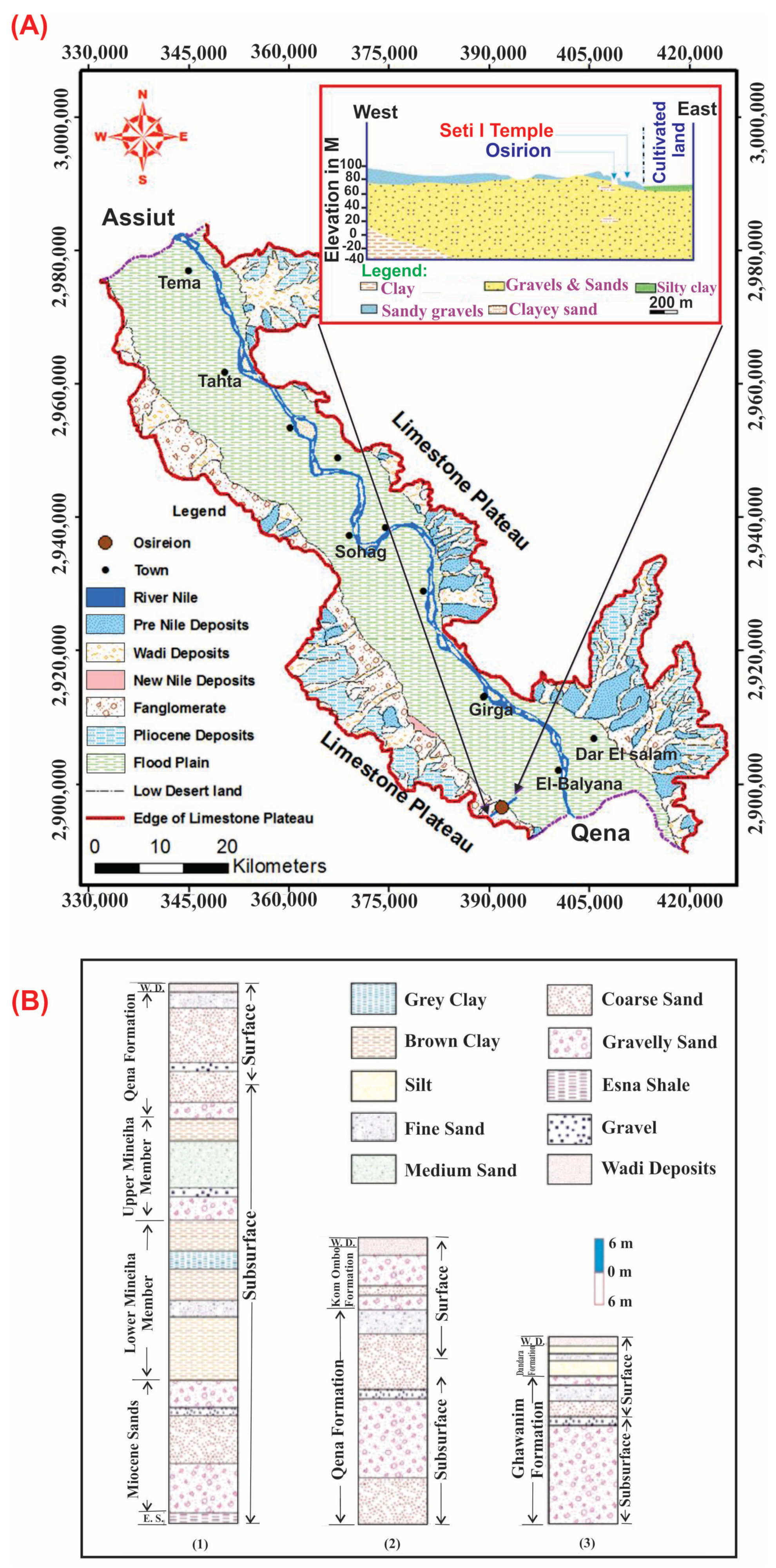
4. Material and Methods
4.1. Shallow Seismic Refraction Method
4.2. Data Acquisition
4.3. Data Processing
5. Results and Discussion
6. Calculation of the Elastic, Geotechnical, Vs30, and Petrophysical Properties
6.1. Petrophysical Parameters
6.2. Elastic Moduli
6.3. Geotechnical Parameters
6.4. Vs30 of Soil and Rocks
7. Conclusions
- Three geoseismic layers were deduced according to the vertical and the horizontal variation in the velocities for both P- and S-waves. The lithologies of these three layers from the top to the base were (i) wadi deposits, which were made up of a mixture of gravel, sand, and silt that were distinguished by incompetent to slightly competent materials, a relatively high porosity ratio, and a larger portion of voids; (ii) sand and muddy sand deposits of reasonably to moderately competent rock quality, intermediate porosity, and greater competence than the top layer; and (iii) clay deposits of competent materials, lower void ratio, and porosity materials.
- The thicknesses of the two successive near-surface layers varied between 1.5 and 4.8 m for the first layer and 14.7 to 35 m for the second one.
- The site was categorized as a “B” site class according to NEHRP classification.
- According to the interpretation of seismic wave velocities and the final geoseismic models, there was no fracturing or faulting in front of the Osirion site.
Author Contributions
Funding
Data Availability Statement
Acknowledgments
Conflicts of Interest
Abbreviations
| SRT | Seismic refraction tomography |
| Φ | Porosity |
| e | Void ratio |
| ρ | Density |
| Poisson’s ratio | |
| µ | Rigidity or Shear modulus |
| E | Young’s modulus |
| K | Bulk modulus |
| Ci | Concentration index |
| Si | Stress ratio |
| Mi | Material index |
| N-value | Liquefaction Potentiality |
| SPT | Standard penetration test |
| qult | Ultimate Bearing Capacity |
| δ | Settlement |
| Vs30 | Averaging Vs for the highest 30 m |
| NEHRP | National Earthquake Hazards Reduction Program |
| 1D | One dimension |
| 2D | Two dimension |
| 3D | Three dimension |
| T-D curve | Time Distance curve |
| Hz | Hertz |
References
- Gaffney, C. Detecting trends in the prediction of the buried past: A review of geophysical techniques in archaeology. Archaeometry 2008, 50, 313–336. [Google Scholar] [CrossRef]
- Hasan, M.; Shang, Y.; Yi, X.; Shao, P.; He, M. Determination of rock mass integrity coefficient using a non-invasive geophysical approach. J. Rock Mech. Geotech. Eng. 2022; in press. [Google Scholar] [CrossRef]
- Cheong, S.; Kim, Y.-J.; Chun, J.-H.; Kim, J.-K.; Huh, S. Integrated Offshore Seismic Survey Using an Unmanned Wave Glider. Energies 2021, 14, 297. [Google Scholar] [CrossRef]
- Wang, C.; Xiao, J.; Liu, W.; Ma, Z. Unloading and reloading stress-strain relationship of recycled aggregate concrete reinforced with steel/polypropylene fibers under uniaxial low-cycle loadings. Cem. Concr. Compos. 2022, 131, 104597. [Google Scholar] [CrossRef]
- Scislo, L. High Activity Earthquake Swarm Event Monitoring and Impact Analysis on Underground High Energy Physics Research Facilities. Energies 2022, 15, 3705. [Google Scholar] [CrossRef]
- Abdel Gowad, A.M.; Punzo, M.; Fiore, V.D.; Tarallo, D.; El-Haddad, A.; Al-Akraby, A.H. Shallow seismic refraction tomography and MASW survey for investigating the fractures along Qena-Safaga Road, South of Egypt. In Engineering Geology and Geological Engineering for Sustainable Use of the Earth’s Resources, Urbanization and Infrastructure Protection from Geohazards: Proceedings of the 1st GeoMEast International Congress and Exhibition, Egypt 2017 on Sustainable Civil Infrastructures 1; Springer: Cham, Switzerland, 2017; pp. 165–191. [Google Scholar]
- NEHRP. Recommended provisions for seismic regulations for new buildings and other structures. In Building Seismic Safety Council (BSSC) for the Federal Emergency Management Agency (FEMA 450); Part 1: Provisions; FEMA: Washington, DC, USA, 2003. [Google Scholar]
- BSSC (Building Seismic Safety Council). NEHRP recommended provisions for seismic regulations for new buildings and other structures. In Report FEMA-450 (Provisions); Federal Emergency Management Agency (FEMA): Washington, DC, USA, 2003. [Google Scholar]
- Dobry, R.; Borcherdt, R.; Crouse, C.; Idriss, I.; Joyner, W.; Martin, G.R.; Power, M.; Rinne, E.; Seed, R. New site coefficients and site classification system used in recent building seismic code provisions. Earthq. Spectra 2000, 16, 41–67. [Google Scholar] [CrossRef]
- Omer, A.; Issawi, B. Lithostratigraphical, mineralogical and geochemical studies on the Neogene and Quaternary Nile basin deposits, Qena-Assiut stretch, Egypt. In Proceedings of the 4th International Conference on Geology of the Arab World, Cairo, Egypt, 31 March 1998. [Google Scholar]
- Mahran, T.; El Haddad, A. Facies and depositional environments of Upper Pliocene-Pleistocne Nile sediments around Soihag area, Nile Valley. J Saharian Stud. 1992, 1, 11–40. [Google Scholar]
- Brooks, J.E.; Issawi, B. Groundwater in the Abydos Areas, Egypt; The Flooding of the Osireion; Water Paper, Egyptian Journal of Archaeological and Restoration Studies “EJARS”: Cairo, Egypt, 1992. [Google Scholar]
- Omer, A.; Abdel Moneim, A. Geochemical characteristics of the Pliocene and Pleistocene Nile basin deposits and their influence on the groundwater chemistry in Sohag area. Ann. Geol. Surv. Egypt 2001, 24, 567–584. [Google Scholar]
- Abdel Moneim, A. Groundwater studies in and around Abydos Temples, Upper Egypt. J. Geol. Surv. Egypt 1999, 22, 357–368. [Google Scholar]
- Said, R. The Geological Evolution of the River Nile; Springer: New York, NY, USA, 1981; 151p. [Google Scholar]
- El-Haddad, A.; Abdel Moneim, A.; Omer, A. Influence of the transverse channels on the geometrical and hydrochemical characteristics of the Quaternary aquifer in the peripheral areas of the Nile Basin, Sohag, Egypt. In Proceedings of the Bull. of the Third International Conference on the Geology of Africa, Assuit University, Assuit, Egypt, 8–10 February 2003. [Google Scholar]
- Abdel Kareem, H. Geology of the Area West of the Nile Valley between Sohag and Girga. Master’s Thesis, Assiut University, Assiut Governorate, Egypt, 1972. [Google Scholar]
- Omer, A. Geological, Mineralogical and Geochemical Studies on the Neogene and Quaternary Nile Basin Deposits, Qena-Assiut Stretch, Egypt. Ph.D. Thesis, South Valley University, Sohag, Egypt, 1996. [Google Scholar]
- Farfour, M.; Economou, N.; Abdalla, O.; Al-Taj, M. Integration of Geophysical Methods for Doline Hazard Assessment: A Case Study from Northern Oman. Geosciences 2022, 12, 243. [Google Scholar] [CrossRef]
- Farfour, M.; Al-Hosni, T. Mapping of near-surface formations by refraction seismic tomography: A case study from Al-Amerat, Sultanate of Oman. Arab. J. Geosci. 2020, 13, 1–9. [Google Scholar] [CrossRef]
- Reynolds, J.M. An Introduction to Applied and Environmental Geophysics, 2nd ed.; John Wiley & Sons: Hoboken, NJ, USA, 2011. [Google Scholar]
- Dawood, A.; Akiti, T.; Glover, E. Seismic Refraction Investigation at a Radioactive Waste Disposal Site. Geosciences 2012, 2, 7–13. [Google Scholar]
- Leucci, G.; Greco, F.; De Giorgi, L.; Mauceri, R. Three-dimensional image of seismic refraction tomography and electrical resistivity tomography survey in the castle of Occhiola (Sicily, Italy). J. Archaeol. Sci. 2007, 34, 233–242. [Google Scholar] [CrossRef]
- Adewoyin, O.; Joshua, E.; Akinyemi, M.; Omeje, M.; Adagunodo, T.; Joel, E. Engineering Site Investigations using Surface Seismic Refraction Technique. In IOP Conference Series: Earth and Environmental Science; IOP Publishing: Bristol, UK, 2021; p. 012098. [Google Scholar]
- Saad, A.; Shebl, S.; Elsamei, S.; Hamed, D. Application of Shallow Seismic Refraction To Detect Engineering Problems, Madinaty City, Egypt. Curr. Sci. Int. 2013, 2, 15–29. [Google Scholar]
- Bery, A.A. High resolution in seismic refraction tomography for environmental study. Int. J. Geosci. 2013, 4, 792–796. [Google Scholar] [CrossRef] [Green Version]
- Hunter, J.A.; Crow, H.L.; Stephenson, W.J.; Pugin, A.J.-M.; Williams, R.A.; Harris, J.B.; Odum, J.K.; Woolery, E.W. Seismic site characterization with shear wave (SH) reflection and refraction methods. J. Seismol. 2022, 26, 631–652. [Google Scholar] [CrossRef]
- Mohammed, M.; Abudeif, A.; Abd El-aal, A. Engineering geotechnical evaluation of soil for foundation purposes using shallow seismic refraction and MASW in 15th Mayo, Egypt. J. Afr. Earth Sci. 2020, 162, 103721. [Google Scholar] [CrossRef]
- Abudeif, A.; Mohammed, M.; Abd El-Aal, A.; Omar, K.A. Single and multi-channel passive source methods for calculating the shallow S-wave velocity structure and site effect parameters at 15th May City, Egypt. J. Afr. Earth Sci. 2019, 159, 103579. [Google Scholar] [CrossRef]
- Kamal, H.; Saudi, G.; Abd Aal, A.A. Geological, Geotechnical and Geophysical Aspects of Zafarana Wind Farms Sites and Their Expansion at Gabel El Zeit Sites Egypt. In IOP Conference Series: Materials Science and Engineering; IOP Publishing: Bristol, UK, 2020; p. 012005. [Google Scholar]
- Uhlemann, S.; Hagedorn, S.; Dashwood, B.; Maurer, H.; Gunn, D.; Dijkstra, T.; Chambers, J. Landslide characterization using P-and S-wave seismic refraction tomography—The importance of elastic moduli. J. Appl. Geophys. 2016, 134, 64–76. [Google Scholar] [CrossRef] [Green Version]
- Khalil, M.H.; Hanafy, S.M. Geotechnical Parameters from Seismic Measurements: Two Field Examples from Egypt and Saudi ArabiaKhalil and Hanafy: Geotechnical Parameters from Seismic Measurements. J. Environ. Eng. Geophys. 2016, 21, 13–28. [Google Scholar] [CrossRef] [Green Version]
- Luna, R.; Jadi, H. Determination of dynamic soil properties using geophysical methods. In Proceedings of the First International Conference on the Application of Geophysical and NDT Methodologies to Transportation Facilities and Infrastructure, St. Louis, MO, USA, 11–15 December 2000; pp. 1–15. [Google Scholar]
- Lehmann, B. Seismic Traveltime Tomography for Engineering and Exploration Applications; EAGE Publications: Houten, The Netherlands, 2007; 126p. [Google Scholar]
- Abudeif, A.M.; Abdel Aal, G.Z.; Masoud, A.M.; Mohammed, M.A. Detection of Groundwater Pathways to Monitor Their Level Rise in Osirion at Abydos Archaeological Site for Reducing Deterioration Hazards, Sohag, Egypt Using Electrical Resistivity Tomography Technique. Appl. Sci. 2022, 12, 10417. [Google Scholar] [CrossRef]
- Rühl, T. Determination of shallow refractor properties by 3D-CMP refraction seismic techniques. First Break 1995, 13, 69–77. [Google Scholar] [CrossRef]
- Gebrande, H.; Miller, H. Refraktionsseismik. In Angewandte Geowissenschaften II, Methoden der Angewandten Geophysik und Mathematische Verfahren in Geowissenschaften; Bender, F., Ed.; Enke Verlag: Stuttgart, Germany, 1985; pp. 226–260. [Google Scholar]
- Piip, V. Inversion of Refraction Traveltimes by Homogeneous Function Method Is Analogue of CDP Reflection Method. In Proceedings of the 71st EAGE Conference and Exhibition Incorporating SPE EUROPEC, Amsterdam, The Netherlands, 8–11 June 2009; p. cp–127-00204. [Google Scholar]
- Leung, T. Evaluation of seismic refraction interpretation using first arrival raytracing. Geol. Soc. Lond. Eng. Geol. Spec. Publ. 1997, 12, 413–416. [Google Scholar] [CrossRef]
- Golden Software Inc. Surfer for Windows, Powerful Contouring and Gridding, and 3-D Surfer Mapping; Golden Software: Golden, CO, USA, 2015. [Google Scholar]
- Watkins, J.S.; Walters, L.A.; Godson, R.H. Dependence of in-situ compressional-wave velocity on porosity in unsaturated rocks. Geophysics 1972, 37, 29–35. [Google Scholar] [CrossRef]
- El Sharawy, M.S.; Nabawy, B.S. Determination of electrofacies using wireline logs based on multivariate statistical analysis for the Kareem Formation, Gulf of Suez, Egypt. Environ. Earth Sci. 2016, 75, 1394. [Google Scholar] [CrossRef]
- Nabawy, B.S.; El Sharawy, M.S. Hydrocarbon potential, structural setting and depositional environments of Hammam Faraun Member of the Belayim Formation, Southern Gulf of Suez, Egypt. J. Afr. Earth Sci. 2015, 112, 93–110. [Google Scholar] [CrossRef]
- Gardner, G.; Gardner, L.; Gregory, A. Formation velocity and density—The diagnostic basics for stratigraphic traps. Geophysics 1974, 39, 770–780. [Google Scholar] [CrossRef] [Green Version]
- Telford, W.; Geldart, L.; Sheriff, R.; Keys, D. Applied Geophysics; Cambridge University Press: New York, NY, USA, 1976; pp. 1–860. [Google Scholar]
- Toksöz, M.N.; Cheng, C.; Timur, A. Velocities of seismic waves in porous rocks. Geophysics 1976, 41, 621–645. [Google Scholar] [CrossRef]
- Othman, A.A. Construed geotechnical characteristics of foundation beds by seismic measurements. J. Geophys. Eng. 2005, 2, 126–138. [Google Scholar] [CrossRef]
- Mott, P.H.; Dorgan, J.R.; Roland, C. The bulk modulus and Poisson’s ratio of “incompressible” materials. J. Sound Vib. 2008, 312, 572–575. [Google Scholar] [CrossRef]
- Abd El-Rahman, M. The potential of absorption coefficient and seismic quality factor in delineating less sound foundation materials in Jabal Shib Az Sahara area, Northwest of Sanaa, Yemen Arab Republic. Egypt MERC Earth Sci 1991, 5, 181–187. [Google Scholar]
- Abd El-Rahman, M. Evaluation of the Kinetic Moduli of the surface material and application to engineering geologic map at Ma’Barr Sabah area (Dhamar province), Northern Yemen, Egypt. J. Geol. 1989, 33, 229–250. [Google Scholar]
- Stümpel, H.; Kähler, S.; Meissner, R.; Milkereit, B. The use of seismic shear waves and compressional waves for lithological problems of shallow sediments. Geophys. Prospect. 1984, 32, 662–675. [Google Scholar] [CrossRef]
- Imai, T.; Fumoto, H.; Yokota, K. P-and S-Wave Velocities in Subsurface Layers of Ground in Japan; Urawa Research Inst., Oyo Corporation: Saitama, Japan, 1976. [Google Scholar]
- Keceli, A. Soil parameters which can be determined with seismic velocities. Jeofizik 2012, 16, 17–29. [Google Scholar]
- Terzaghi, K.; Peck, R.B.; Mesri, G. Soil Mechanics in Engineering Practice; John Wiley & Sons: Hoboken, NJ, USA, 1996. [Google Scholar]
- EN 1998-1: 2004; Eurocode 8: Design of Structures for Earthquake Resistance-Part 1: General Rules, Seismic Actions and Rules for Buildings. European Committee for Standardization: Brussels, Belgium, 2004.
- Sheriff, R.E.; Geldart, L.P. Exploration Seismology; Cambridge University Press: Cambridge, UK, 1995; Volume 316. [Google Scholar]
- Bowles, J.E. Foundation Analysis and Design, 2nd ed.; McGraw-Hill International Book Company: London, UK, 1988; p. 587. [Google Scholar]
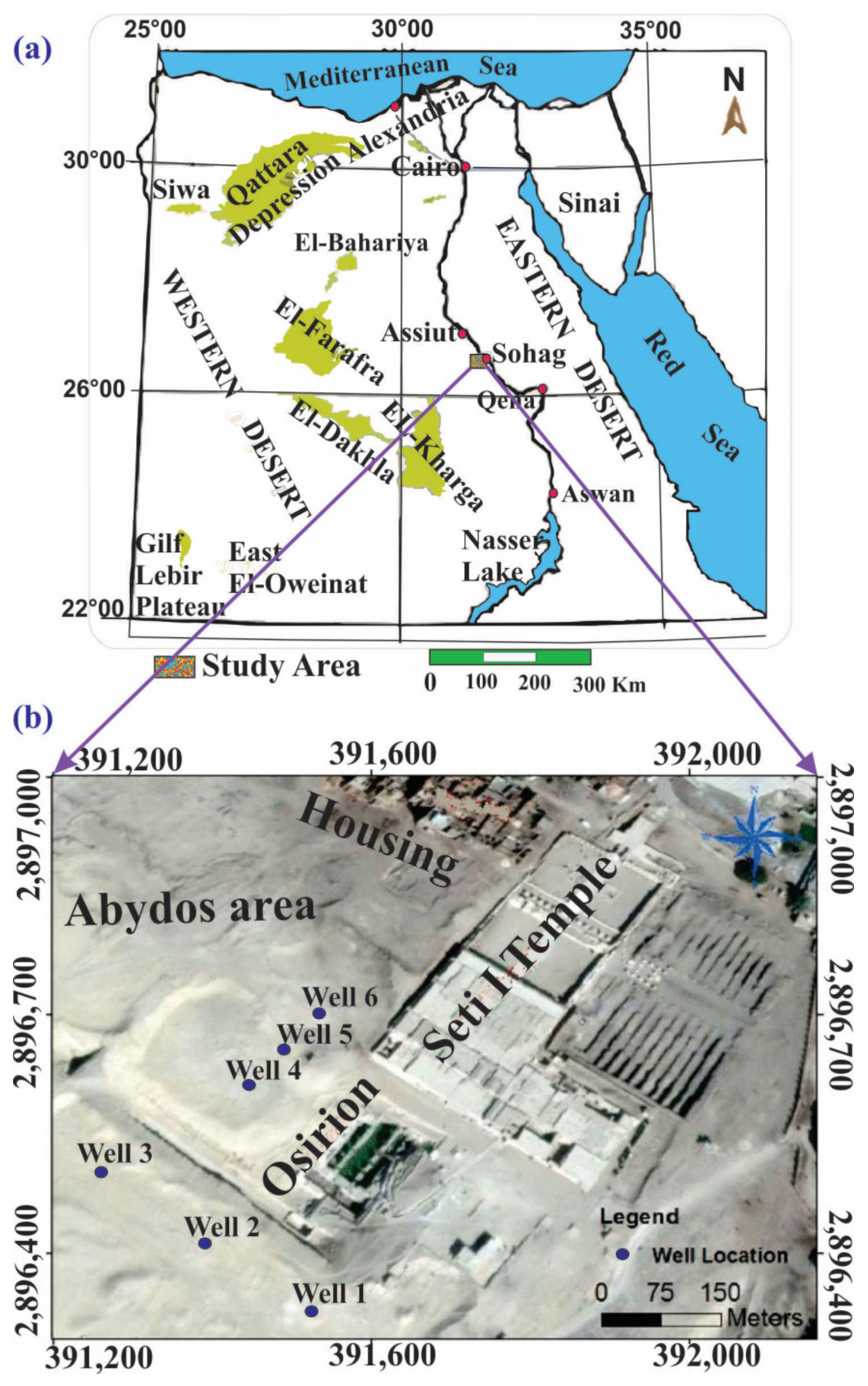


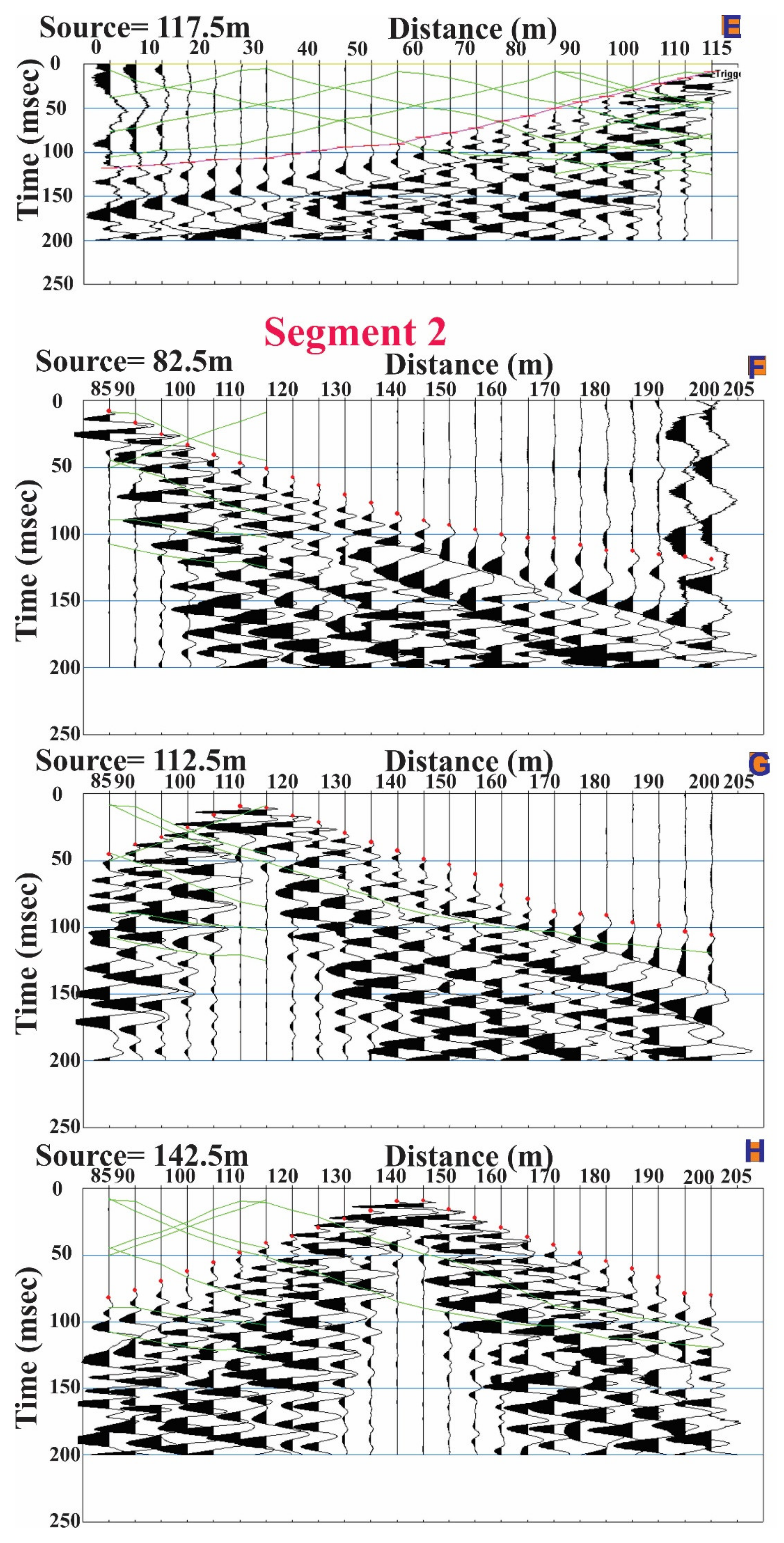

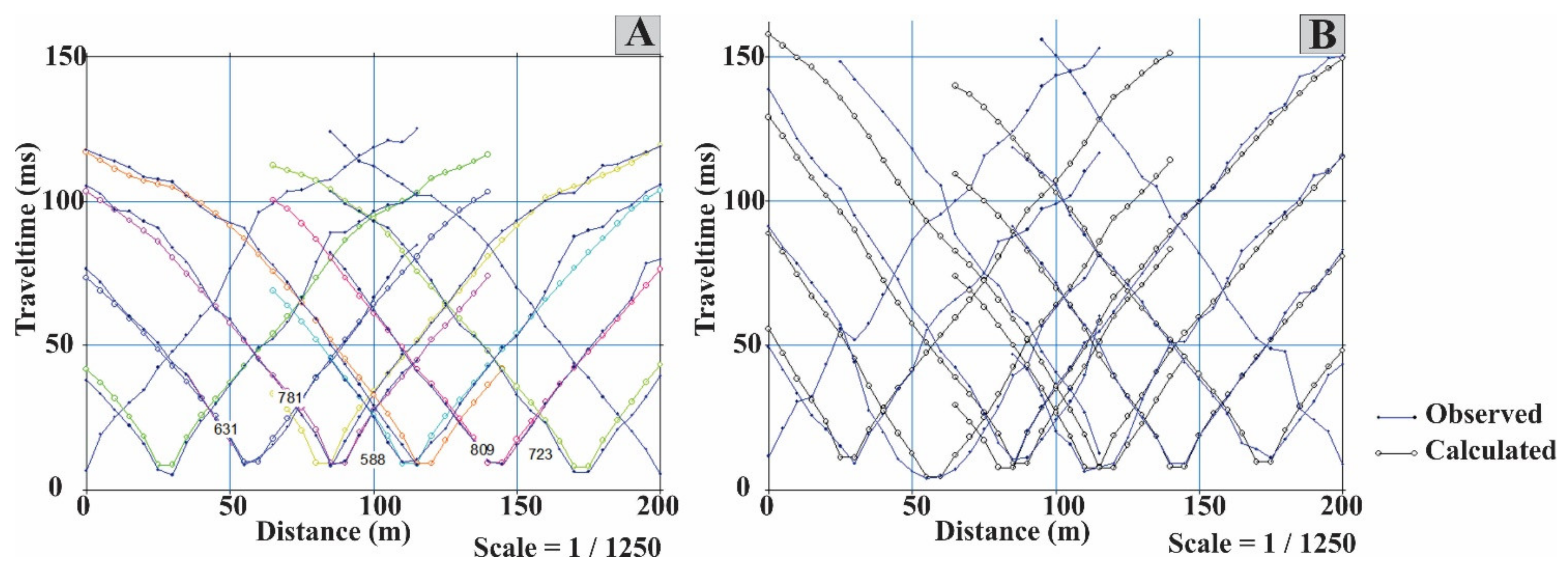

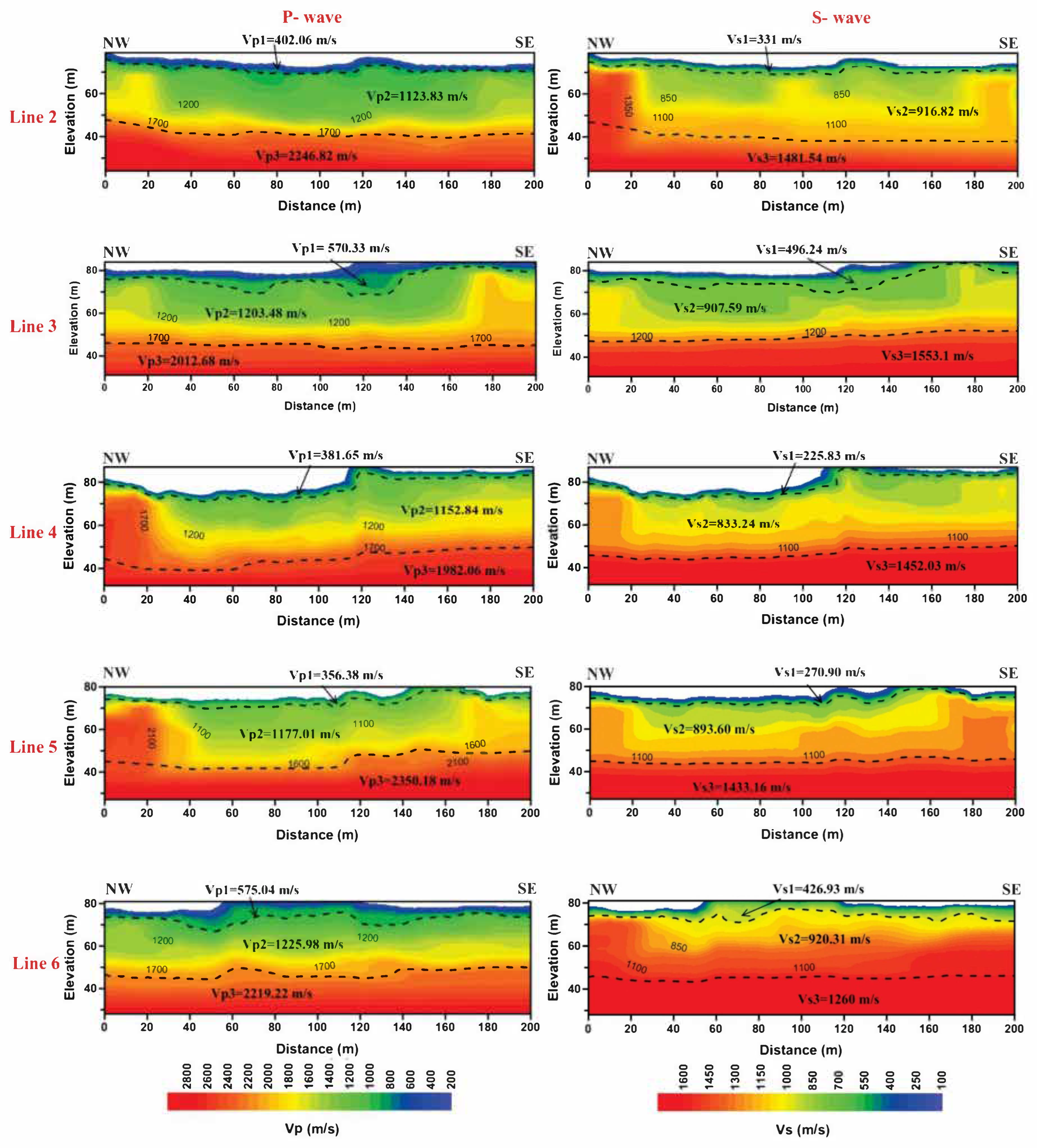


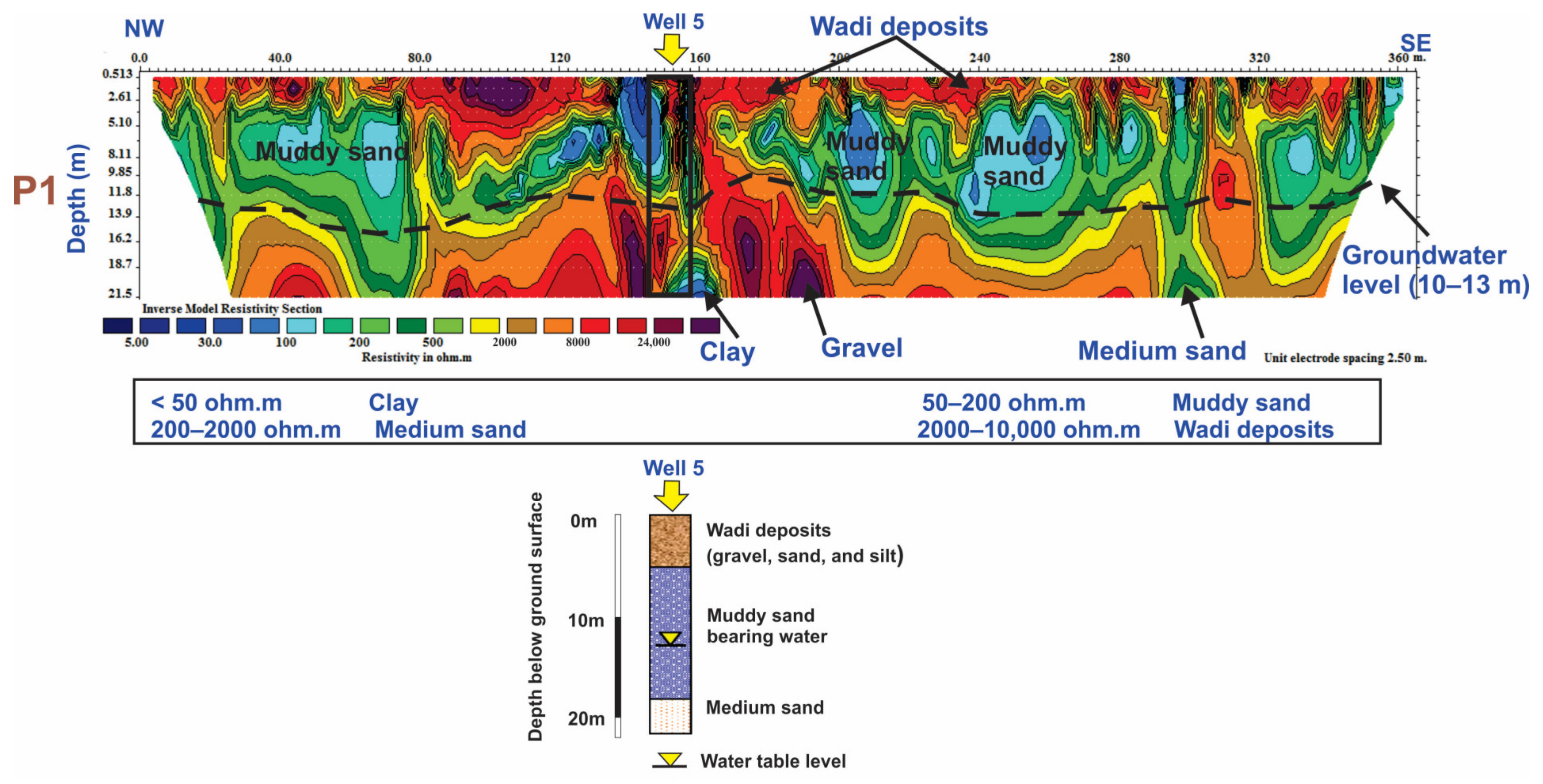


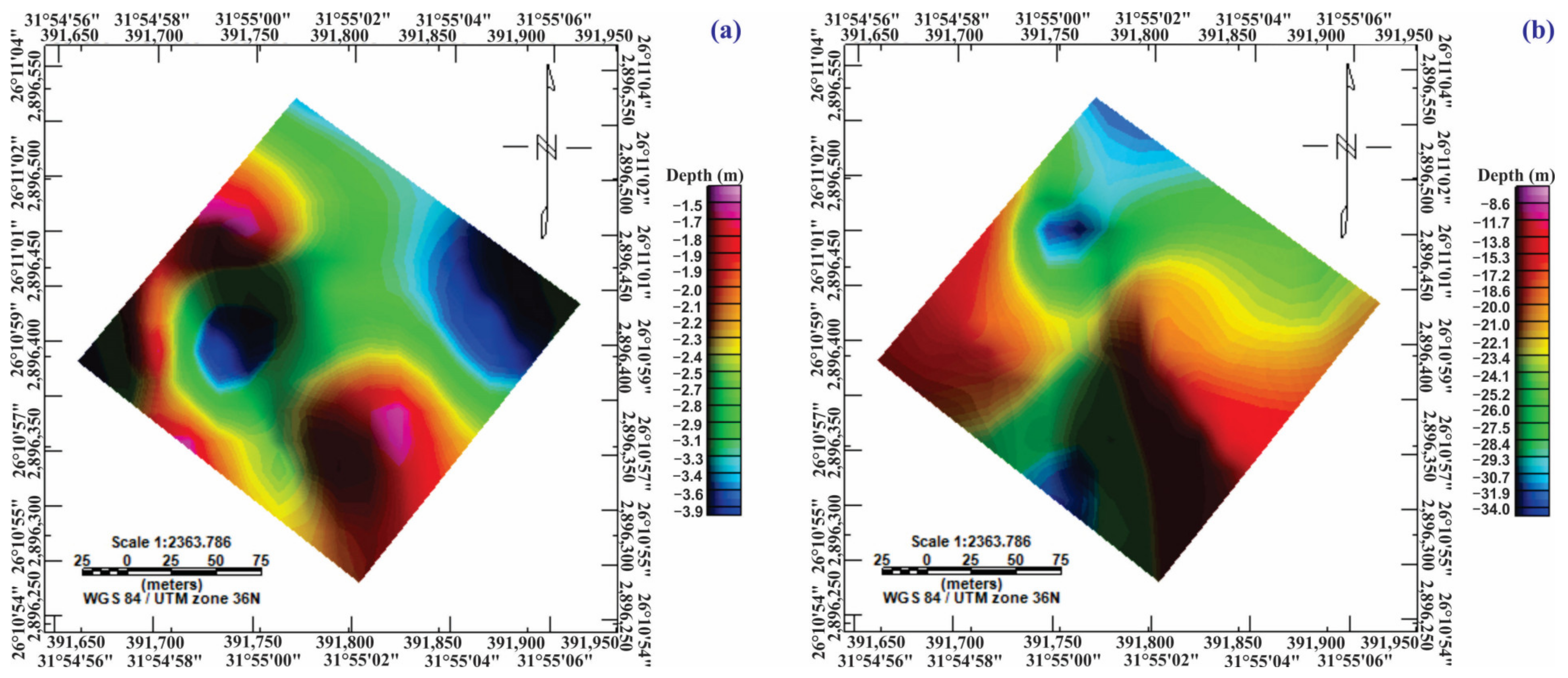
| Profile No. | First Layer | Second Layer | Third Layer | Depth to the Top of | ||||
|---|---|---|---|---|---|---|---|---|
| Vp (m/s) | Vs (m/s) | Vp (m/s) | Vs (m/s) | Vp (m/s) | Vs (m/s) | Second Layer | Third Layer | |
| 1 | 506.46 | 447.85 | 1152.5 | 904.48 | 2250.78 | 1513.74 | −3.6 | −18.7 |
| 2 | 402.06 | 331 | 1123.83 | 916.82 | 2246.82 | 1481.54 | −1.5 | −19.5 |
| 3 | 570.33 | 496.24 | 1203.48 | 907.59 | 2012.68 | 1553.1 | −4.8 | −18.9 |
| 4 | 381.65 | 225.83 | 1152.84 | 833.24 | 1982.06 | 1452.03 | −1.5 | −14.7 |
| 5 | 356.38 | 270.9 | 1177.01 | 893.6 | 2350.18 | 1433.16 | −1.8 | −18.1 |
| 6 | 575.04 | 426.93 | 1225.98 | 920.31 | 2219.22 | 1260 | −3.1 | −19.7 |
| 7 | 618.2 | 496.15 | 1234.22 | 970.75 | 2242.66 | 1706.72 | −4.8 | −23.0 |
| 8 | 534.63 | 382.5 | 1214.56 | 911.85 | 2401.43 | 1356.7 | −2.3 | −19.2 |
| 9 | 609.61 | 488.14 | 1303.6 | 1093.96 | 2821.81 | 1571.72 | −3.6 | −32.7 |
| 10 | 460.68 | 289.05 | 1117.34 | 999.51 | 2181.71 | 1660.25 | −2.0 | −25.1 |
| 11 | 496.88 | 336.92 | 1232.47 | 1119.74 | 2355.25 | 1676.03 | −1.6 | −35.0 |
| 12 | 387.86 | 242.09 | 1113.91 | 968.43 | 2094.58 | 1680.86 | −1.6 | −22.9 |
| 13 | 431.65 | 332.46 | 1125.18 | 1000.62 | 2277.07 | 1632.53 | −2.5 | −25.2 |
| 14 | 435.59 | 241.65 | 1113.46 | 1080.89 | 2529.66 | 1896.28 | −2.6 | −31.6 |
| 15 | 445.53 | 244.25 | 1196.34 | 941.42 | 2280.94 | 1512.41 | −2.6 | −21.1 |
| 16 | 480.23 | 393.58 | 1134.02 | 972.68 | 2239.45 | 1554.84 | −2.4 | −23.2 |
| 17 | 491.09 | 287 | 1064.44 | 892.09 | 1955 | 1155 | −2.0 | −18.0 |
| Min | 356.38 | 225.83 | 1064.44 | 833.24 | 1955 | 1155 | ||
| Max | 618.2 | 496.24 | 1303.6 | 1119.74 | 2821.81 | 1896.28 | ||
| Type | Parameter | The Formula Employed | References |
|---|---|---|---|
| Petrophysical parameters | Porosity (Φ) | Φ = −0.175 ln (Vp) + 1.56 | [41] |
| Void ratio (e) | e = Φ/(1 − Φ) | [42,43] | |
| Elastic moduli and density | Rock density (ρ) | . Vp in m/s, a = 0.31 when the density is given in g/cm3. | [44] |
| Poisson’s ratio () | [45] | ||
| Rigidity modulus (µ) | [46] | ||
| Young’s modulus (E) | [47] | ||
| Bulk modulus (K) | [48] | ||
| Geotechnical parameters | Concentration index (Ci) | [49] | |
| Stress Ratio (Si) | [49] | ||
| Material Index (Mi) | Mi = where is Poisson’s ratio | [50] | |
| Liquefaction potentiality (N-value) | [51,52] | ||
| Ultimate bearing capacity (qult) | where γ is the ground’s unit weight, is the density of the rocks, and Vs is the velocity of the shear waves. | [53] | |
| Settlement (δ) | where: qult for the load at unit area is the stress value depending on the depth z, δz is the settlement value for the soil column with the depth z. | [54] | |
| Vs30 | Vs30 | where Vi and hi indicate the thickness (m) and the Vs of the ith layer present in the top 30 m, respectively. | [55] |
| P. | Layer | Petrophysical | Elastic Moduli and Density | Geotechnical Parameters | Vs30 | ||||||||||
|---|---|---|---|---|---|---|---|---|---|---|---|---|---|---|---|
| Φ | e | ρ | σ | µ | E | K | Ci | Si | Mi | N-Value | Qult | δ | |||
| (g/cm3) | (dyn/cm2) | (dyn/cm2) | (dyn/cm2) | (kg/cm2) | (cm) | (m/s) | |||||||||
| 1 | 1 | 0.47 | 0.89 | 1.47 | −1.29 | 2.95 × 109 | 1.73 × 109 | 1.60 × 108 | 0.23 | −0.56 | 6.17 | >50 | 3.32 | −4.59 × 10−3 | 1044.8 |
| 2 | 0.33 | 0.48 | 1.81 | −0.30 | 1.48 × 1010 | 2.06 × 1010 | 4.29 × 109 | −2.31 | −0.23 | 2.21 | 26.11 | 2.37 × 10−2 | |||
| 3 | 0.21 | 0.26 | 2.14 | 0.09 | 4.89 × 1010 | 1.06 × 1011 | 4.29 × 1010 | 12.48 | 0.10 | 0.65 | 118.17 | 9.42 × 10−2 | |||
| 2 | 1 | 0.51 | 1.04 | 1.39 | −0.55 | 1.52 × 109 | 1.36 × 109 | 2.16 × 108 | −0.81 | −0.36 | 3.21 | 45.7 | 1.37 | 9.87 × 10−4 | 1162.8 |
| 2 | 0.33 | 0.49 | 1.79 | −0.49 | 1.51 × 1010 | 1.52 × 1010 | 2.55 × 109 | −1.02 | −0.33 | 2.98 | >50 | 27.17 | 3.47 × 10−2 | ||
| 3 | 0.21 | 0.27 | 2.13 | 0.12 | 4.68 × 1010 | 1.05 × 1011 | 4.52 × 1010 | 9.67 | 0.13 | 0.54 | 110.95 | 8.45 × 10−2 | |||
| 3 | 1 | 0.45 | 0.82 | 1.51 | −1.06 | 3.73 × 109 | 4.34 × 108 | 4.63 × 107 | 0.05 | −0.51 | 5.23 | 4.49 | −3.34 × 10−2 | 983.7 | |
| 2 | 0.32 | 0.47 | 1.83 | −0.16 | 1.50 × 1010 | 2.53 × 1010 | 6.39 × 109 | −5.28 | −0.14 | 1.64 | 26.37 | 1.97 × 10−2 | |||
| 3 | 0.23 | 0.30 | 2.08 | −0.24 | 5.01 × 1010 | 7.65 × 1010 | 1.73 × 1010 | −3.24 | −0.19 | 1.94 | 127.41 | 1.52 × 10−1 | |||
| 4 | 1 | 0.52 | 1.08 | 1.37 | 0.23 | 6.99 × 108 | 1.72 × 109 | 1.06 × 109 | 5.34 | 0.30 | 0.08 | 14.9 | 0.45 | 8.32 × 10−5 | 1235.4 |
| 2 | 0.33 | 0.48 | 1.81 | −0.05 | 1.25 × 1010 | 2.39 × 1010 | 7.28 × 109 | −20.32 | −0.04 | 1.19 | >50 | 20.53 | 1.26 × 10−2 | ||
| 3 | 0.23 | 0.30 | 2.07 | −0.08 | 4.36 × 1010 | 8.03 × 1010 | 2.31 × 1010 | −11.63 | −0.07 | 1.32 | 104.60 | 9.77 × 10−2 | |||
| 5 | 1 | 0.53 | 1.14 | 1.35 | −0.18 | 9.88 × 108 | 1.61 × 109 | 3.92 × 108 | −4.43 | −0.16 | 1.74 | 25.4 | 0.76 | 2.58 × 10−4 | 1115.3 |
| 2 | 0.32 | 0.48 | 1.82 | −0.18 | 1.45 × 1010 | 2.38 × 1010 | 5.82 × 109 | −4.54 | −0.15 | 1.72 | >50 | 25.20 | 1.92 × 10−2 | ||
| 3 | 0.20 | 0.25 | 2.16 | 0.20 | 4.43 × 1010 | 1.07 × 1011 | 6.00 × 1010 | 5.90 | 0.26 | 0.18 | 100.66 | 6.81 × 10−2 | |||
| 6 | 1 | 0.45 | 0.81 | 1.52 | −0.11 | 2.77 × 109 | 4.90 × 109 | 1.33 × 109 | −7.76 | −0.10 | 1.46 | 2.89 | 1.22 × 10−3 | 1046.5 | |
| 2 | 0.32 | 0.46 | 1.83 | −0.15 | 1.55 × 1010 | 2.66 × 1010 | 6.85 × 109 | −5.87 | −0.13 | 1.58 | 27.47 | 2.04 × 10−2 | |||
| 3 | 0.21 | 0.27 | 2.13 | 0.26 | 3.38 × 1010 | 8.53 × 1010 | 5.97 × 1010 | 4.81 | 0.36 | −0.05 | 69.01 | 4.01 × 10−2 | |||
| 7 | 1 | 0.44 | 0.77 | 1.55 | −0.40 | 3.81 × 109 | 4.53 × 109 | 8.33 × 108 | −1.47 | −0.29 | 2.62 | 4.49 | 3.19 × 10−3 | 899.1 | |
| 2 | 0.31 | 0.46 | 1.84 | −0.31 | 1.73 × 1010 | 2.39 × 1010 | 4.90 × 109 | −2.21 | −0.24 | 2.24 | 32.12 | 3.10 × 10−2 | |||
| 3 | 0.21 | 0.27 | 2.13 | −0.19 | 6.21 × 1010 | 1.01 × 1011 | 2.44 × 1010 | −4.32 | −0.16 | 1.75 | 85.71 | 5.21 × 10−2 | |||
| 8 | 1 | 0.46 | 0.85 | 1.49 | −0.02 | 2.18 × 109 | 4.26 × 109 | 1.35 × 109 | −40.14 | −0.02 | 1.10 | 2.09 | 7.39 × 10−4 | 1108.3 | |
| 2 | 0.32 | 0.46 | 1.83 | −0.15 | 1.52 × 1010 | 2.60 × 1010 | 6.70 × 109 | −5.86 | −0.13 | 1.58 | 26.74 | 1.97 × 10−2 | |||
| 3 | 0.20 | 0.25 | 2.17 | 0.27 | 3.99 × 1010 | 1.01 × 1011 | 7.18 × 1010 | 4.77 | 0.36 | −0.06 | 168.00 | 2.01 × 10−1 | |||
| 9 | 1 | 0.44 | 0.78 | 1.54 | −0.39 | 3.67 × 109 | 4.45 × 109 | 8.30 × 108 | −1.54 | −0.28 | 2.57 | 4.28 | 2.95 × 10−3 | 805.0 | |
| 2 | 0.31 | 0.44 | 1.86 | −0.69 | 2.23 × 1010 | 1.38 × 1010 | 1.93 × 109 | −0.45 | −0.41 | 3.76 | 45.60 | 1.08 × 10−1 | |||
| 3 | 0.17 | 0.20 | 2.26 | 0.28 | 5.58 × 1010 | 1.42 × 1011 | 1.05 × 1011 | 4.63 | 0.38 | −0.10 | 131.94 | 8.77 × 10−2 | |||
| 10 | 1 | 0.49 | 0.95 | 1.44 | 0.18 | 1.20 × 109 | 2.82 × 109 | 1.45 × 109 | 6.70 | 0.21 | 0.30 | 30.7 | 0.92 | 2.16 × 10−4 | 936.6 |
| 2 | 0.33 | 0.50 | 1.79 | −1.50 | 1.79 × 1010 | 1.80 × 1010 | 1.50 × 109 | 0.33 | −0.60 | 7.01 | >50 | 34.99 | −4.88 × 10−2 | ||
| 3 | 0.22 | 0.27 | 2.12 | −0.19 | 5.84 × 1010 | 9.48 × 1010 | 2.30 × 1010 | −4.32 | −0.16 | 1.75 | 154.93 | 1.82 × 10−1 | |||
| 11 | 1 | 0.47 | 0.90 | 1.46 | 0.07 | 1.66 × 109 | 3.57 × 109 | 1.40 × 109 | 14.43 | 0.08 | 0.70 | 48.2 | 1.44 | 4.18 × 10−4 | 833.2 |
| 2 | 0.32 | 0.46 | 1.84 | −1.86 | 2.30 × 1010 | 3.98 × 1010 | 2.80 × 109 | 0.46 | −0.65 | 8.46 | >50 | 48.82 | −4.30 × 10−2 | ||
| 3 | 0.20 | 0.25 | 2.16 | −0.01 | 6.07 × 1010 | 1.20 × 1011 | 3.89 × 1010 | −76.18 | −0.01 | 1.05 | 159.29 | 1.52 × 10−1 | |||
| 12 | 1 | 0.52 | 1.07 | 1.38 | 0.18 | 8.06 × 108 | 1.90 × 109 | 9.94 × 108 | 6.53 | 0.22 | 0.28 | 18.3 | 0.55 | 1.13 × 10−4 | 991.6 |
| 2 | 0.33 | 0.50 | 1.79 | −1.05 | 1.68 × 1010 | 1.61 × 109 | 1.73 × 108 | 0.05 | −0.51 | 5.19 | >50 | 31.90 | −4.53 × 10−1 | ||
| 3 | 0.22 | 0.29 | 2.10 | −0.40 | 5.93 × 1010 | 7.06 × 1010 | 1.30 × 1010 | −1.47 | −0.29 | 2.62 | 160.64 | 2.62 × 10−1 | |||
| 13 | 1 | 0.50 | 0.99 | 1.41 | −0.23 | 1.56 × 109 | 2.41 × 109 | 5.50 × 108 | −3.36 | −0.19 | 1.92 | 46.3 | 1.39 | 5.74 × 10−4 | 917.3 |
| 2 | 0.33 | 0.49 | 1.80 | −1.39 | 1.80 × 1010 | 1.40 × 1010 | 1.24 × 109 | 0.28 | −0.58 | 6.56 | >50 | 35.11 | −6.29 × 10−2 | ||
| 3 | 0.21 | 0.26 | 2.14 | −0.03 | 5.71 × 1010 | 1.11 × 1011 | 3.49 × 1010 | −33.69 | −0.03 | 1.12 | 147.47 | 1.41 × 10−1 | |||
| 14 | 1 | 0.50 | 0.99 | 1.42 | 0.28 | 8.27 × 108 | 2.11 × 109 | 1.58 × 109 | 4.60 | 0.38 | −0.11 | 18.2 | 0.54 | 1.01 × 10−4 | 760.1 |
| 2 | 0.33 | 0.50 | 1.79 | −7.67 | 2.09 × 1010 | 2.79 × 1011 | 5.69 × 109 | 0.87 | −0.88 | 31.69 | >50 | 44.02 | −4.98 × 10−3 | ||
| 3 | 0.19 | 0.23 | 2.20 | −0.14 | 7.91 × 1010 | 1.36 × 1011 | 3.52 × 1010 | −6.07 | −0.12 | 1.57 | 228.78 | 2.77 × 10−1 | |||
| 15 | 1 | 0.49 | 0.97 | 1.42 | 0.29 | 8.50 × 108 | 2.18 × 109 | 1.69 × 109 | 4.51 | 0.40 | −0.14 | 18.7 | 0.56 | 1.04 × 10−4 | 907.5 |
| 2 | 0.32 | 0.47 | 1.82 | −0.31 | 1.62 × 1010 | 2.22 × 1010 | 4.54 × 109 | −2.19 | −0.24 | 2.25 | >50 | 29.36 | 2.79 × 10−2 | ||
| 3 | 0.21 | 0.26 | 2.14 | 0.11 | 4.90 × 1010 | 1.09 × 1011 | 4.61 × 1010 | 10.29 | 0.12 | 0.57 | 117.87 | 9.18 × 10−2 | |||
| 16 | 1 | 0.48 | 0.92 | 1.45 | −0.52 | 2.25 × 109 | 2.14 × 109 | 3.49 × 108 | −0.91 | −0.34 | 3.09 | 2.28 | 1.73 × 10−3 | 1001.7 | |
| 2 | 0.33 | 0.49 | 1.80 | −0.89 | 1.70 × 1010 | 3.68 × 109 | 4.41 × 108 | −0.12 | −0.47 | 4.57 | 32.31 | 2.03 × 10−1 | |||
| 3 | 0.21 | 0.27 | 2.13 | 0.03 | 5.16 × 1010 | 1.07 × 1011 | 3.82 × 1010 | 29.85 | 0.04 | 0.86 | 127.83 | 1.10 × 10−1 | |||
| 17 | 1 | 0.48 | 0.91 | 1.46 | 0.24 | 1.20 × 109 | 2.98 × 109 | 1.91 × 109 | 5.16 | 0.32 | 0.04 | 30.1 | 0.90 | 1.96 × 10−4 | 1105.1 |
| 2 | 0.34 | 0.52 | 1.77 | −0.68 | 1.41 × 1010 | 9.02 × 109 | 1.27 × 109 | −0.47 | −0.40 | 3.72 | >50 | 25.07 | 5.00 × 10−2 | ||
| 3 | 0.23 | 0.31 | 2.06 | 0.23 | 2.75 × 1010 | 6.78 × 1010 | 4.21 × 1010 | 5.31 | 0.30 | 0.07 | 53.47 | 3.03 × 10−2 | |||
Disclaimer/Publisher’s Note: The statements, opinions and data contained in all publications are solely those of the individual author(s) and contributor(s) and not of MDPI and/or the editor(s). MDPI and/or the editor(s) disclaim responsibility for any injury to people or property resulting from any ideas, methods, instructions or products referred to in the content. |
© 2023 by the authors. Licensee MDPI, Basel, Switzerland. This article is an open access article distributed under the terms and conditions of the Creative Commons Attribution (CC BY) license (https://creativecommons.org/licenses/by/4.0/).
Share and Cite
Abudeif, A.M.; Abdel Aal, G.Z.; Abdelbaky, N.F.; Abdel Gowad, A.M.; Mohammed, M.A. Evaluation of Engineering Site and Subsurface Structures Using Seismic Refraction Tomography: A Case Study of Abydos Site, Sohag Governorate, Egypt. Appl. Sci. 2023, 13, 2745. https://doi.org/10.3390/app13042745
Abudeif AM, Abdel Aal GZ, Abdelbaky NF, Abdel Gowad AM, Mohammed MA. Evaluation of Engineering Site and Subsurface Structures Using Seismic Refraction Tomography: A Case Study of Abydos Site, Sohag Governorate, Egypt. Applied Sciences. 2023; 13(4):2745. https://doi.org/10.3390/app13042745
Chicago/Turabian StyleAbudeif, Abdelbaset M., Gamal Z. Abdel Aal, Nessreen F. Abdelbaky, Ahmed M. Abdel Gowad, and Mohammed A. Mohammed. 2023. "Evaluation of Engineering Site and Subsurface Structures Using Seismic Refraction Tomography: A Case Study of Abydos Site, Sohag Governorate, Egypt" Applied Sciences 13, no. 4: 2745. https://doi.org/10.3390/app13042745
APA StyleAbudeif, A. M., Abdel Aal, G. Z., Abdelbaky, N. F., Abdel Gowad, A. M., & Mohammed, M. A. (2023). Evaluation of Engineering Site and Subsurface Structures Using Seismic Refraction Tomography: A Case Study of Abydos Site, Sohag Governorate, Egypt. Applied Sciences, 13(4), 2745. https://doi.org/10.3390/app13042745







